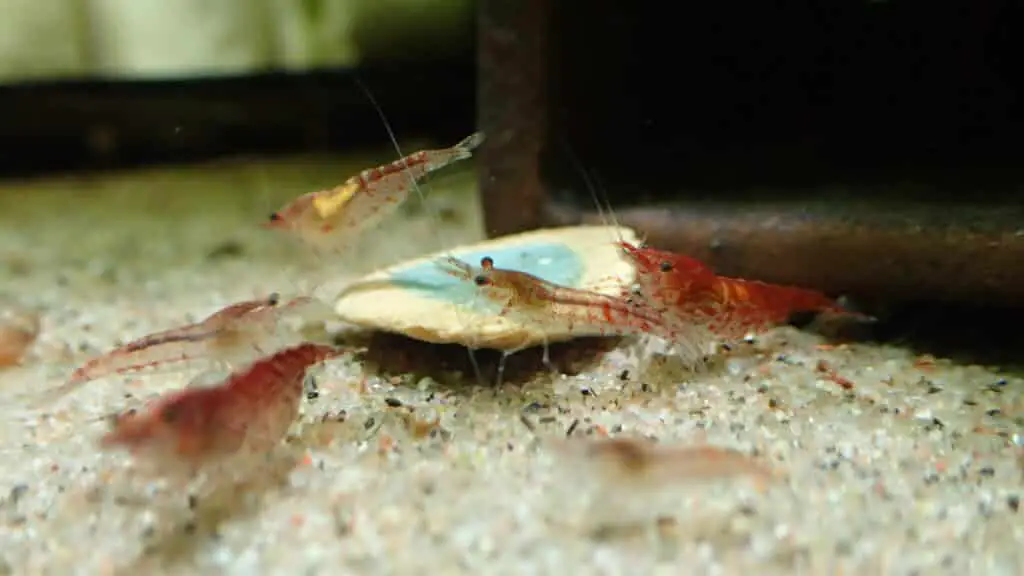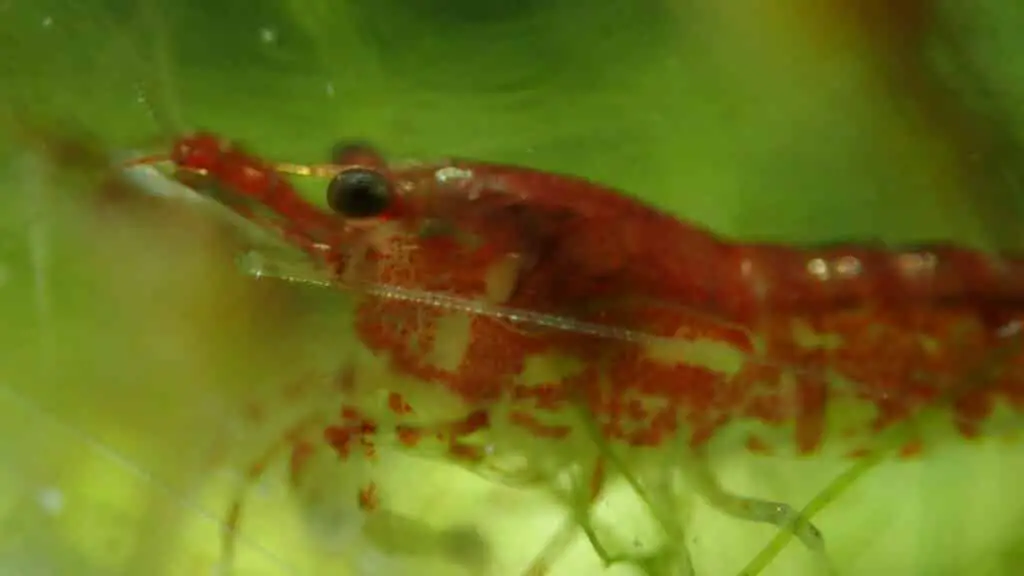Did a moment ever arise when the usually vibrant red hues of your cherry shrimp seemed a bit… faded in your aquarium? Many aquarists have experienced this puzzling phenomenon, where the once brilliantly colored cherry shrimp seem to have lost their luster. For example, you might have noticed that your shrimp, which were once a deep, fiery red, have now turned a pale pink or even a dull gray.
The loss of color in cherry shrimp can be attributed to several factors, including stress, poor diet, suboptimal water conditions, or simply aging.
Hello, fellow shrimp keepers! I’ve been keeping cherry shrimp for over a decade now, and let me tell you, it’s been quite the adventure. There’s nothing quite like the sight of a thriving shrimp colony, their red bodies darting around the tank, adding a splash of color to my living room. But it hasn’t always been smooth sailing.
I remember the first time I noticed my shrimp losing their color. It was a few years into my shrimp-keeping journey, and I was baffled. My once vibrant shrimp were turning pale, and I had no idea why. I felt worried every time I looked at my tank, wondering if I was doing something wrong.
Over the years, I’ve faced this challenge multiple times, and each time, I’ve learned a little more about what could be causing it. I’ve tweaked their diet, adjusted the water parameters, and even tried different tank mates. It’s been a process of trial and error, but with each change, I’ve seen improvements.
In this article, I’ll share with you what I’ve learned about why cherry shrimp lose their color and what you can do about it. So, buckle up and get ready for a deep dive into the colorful world of cherry shrimp keeping!
What are the signs of stress in cherry shrimp?
When it comes to understanding the health and well-being of our cherry shrimp, it’s crucial to recognize the signs of stress. Stress in cherry shrimp can manifest in several ways, and color loss is often one of the first noticeable symptoms. However, it’s not the only sign.
One of the most common signs of stress in cherry shrimp is a change in their behavior. A stressed shrimp may become less active, spending more time hiding or remaining stationary. You might notice them clinging to the sides of the tank or the filter, which can indicate that they’re not feeling their best.
Another sign of stress is a change in eating habits. Cherry shrimp are usually voracious eaters, so if you notice that your shrimp are not eating as much as usual or ignoring food altogether, it could be a sign that they’re stressed.
Additionally, rapid or erratic swimming can also be a sign of stress. This behavior, often referred to as “shrimp zoomies,” can indicate that something in the tank is causing them discomfort.
Lastly, frequent molting can be a sign of stress. While molting is a normal part of a shrimp’s life cycle, if it happens too often, it can indicate that the shrimp is under stress.
Each shrimp is unique, and what’s normal behavior for one might not be for another. The key is to observe your shrimp regularly and note any changes in behavior, appearance, or eating habits. If you notice any of these signs, it’s time to investigate and address any potential stressors in your tank.

How does diet affect the color of cherry shrimp?
The diet of cherry shrimp plays a significant role in their coloration. Just like in humans, what a shrimp eats can greatly influence its overall health and appearance. A well-balanced diet can help maintain their vibrant color, while a poor diet can lead to color loss.
Cherry shrimp are omnivores and in the wild, they feed on a variety of foods including algae, decaying plant matter, and tiny microorganisms. In an aquarium setting, this diet can be replicated by providing them with a mix of commercial shrimp food, blanched vegetables, and occasional protein sources like bloodworms or brine shrimp.
Commercial shrimp foods often contain color-enhancing ingredients like spirulina or astaxanthin, which can help maintain and enhance the red coloration of cherry shrimp. These ingredients are natural carotenoids that the shrimp can store in their bodies, leading to more vibrant colors.
On the other hand, a diet lacking in these essential nutrients can lead to color fading. If a shrimp isn’t getting enough of the right nutrients, it may not be able to maintain its color. This is why it’s important to provide a varied diet that includes all the nutrients your shrimp need to thrive.
However, it’s also important to remember that overfeeding can be just as harmful as underfeeding. Overfeeding can lead to poor water quality, which can stress your shrimp and lead to color loss. So, while a balanced diet is crucial, it’s equally important to feed your shrimp in moderation.
A well-rounded diet is key to maintaining the vibrant color of your cherry shrimp. By providing a variety of foods and ensuring they’re getting the right nutrients, you can help keep your shrimp looking their best.

What water conditions are optimal for cherry shrimp?
Creating the right environment for your cherry shrimp is key to their health and coloration. Water conditions play a significant role in this, and there are several parameters to consider when setting up and maintaining your shrimp tank.
Firstly, temperature is crucial. Cherry shrimp thrive in temperatures between 20 to 27 degrees Celsius (68 to 80 degrees Fahrenheit). Temperatures outside this range can stress your shrimp, potentially leading to color loss and other health issues.
Next, consider the pH level of your water. Cherry shrimp prefer slightly acidic to neutral water, with a pH between 6.5 and 7.5. Extremes in pH can cause stress and harm to your shrimp, so it’s important to monitor this regularly.
Water hardness is another important factor. Cherry shrimp do well in moderately hard water, with a general hardness (GH) of 4-8 and a carbonate hardness (KH) of 3-15. Hardness can affect the shrimp’s ability to molt, which in turn can impact their coloration.
Lastly, the quality of your water is paramount. Your tank should be free of harmful chemicals like ammonia, nitrites, and high levels of nitrates, all of which can be deadly to shrimp. Regular water changes and a good filtration system can help maintain water quality.
Optimal water conditions for cherry shrimp include a suitable temperature, appropriate pH, moderate hardness, and high-quality water free from harmful chemicals. By maintaining these conditions, you can provide a healthy environment for your shrimp, promoting vibrant color and overall well-being.

In Closing: Maintaining Vibrant Cherry Shrimp
Ultimately, the coloration of your cherry shrimp is a reflection of their overall health and well-being. It’s influenced by a variety of factors, from their diet to the conditions of their environment. By understanding these factors, you can take steps to ensure your shrimp maintain their vibrant color.
Ensure your shrimp have a varied and balanced diet, rich in nutrients that enhance their color. Keep a close eye on their behavior for signs of stress, and make necessary adjustments to their environment as needed. Maintain optimal water conditions, including the right temperature, pH, and hardness levels, and keep the water free from harmful chemicals.
On a final note, remember that each shrimp is unique, and what works for one might not work for another. It’s all about observing, learning, and adapting to the needs of your shrimp.
If you need any further help or advice, please don’t hesitate to reach out. If you can’t reach me here, check out the ‘Aquarium Shrimp Keeping’ group on Facebook. There’s a whole community of shrimp enthusiasts who are more than willing to share their knowledge and experiences.
In a nutshell, happy shrimp keeping! May your aquarium always be filled with vibrant, healthy, and colorful cherry shrimp.
FAQ on Cherry Shrimp Coloration
Q. Why is my red shrimp losing color?
A. Red shrimp, including cherry shrimp, can lose color due to several factors such as stress, poor diet, suboptimal water conditions, and aging. Changes in their environment, such as a lighter substrate, can also cause them to adjust their color for camouflage.
Q. How can I improve the color of my shrimp?
A. Improving the color of your shrimp can be achieved by providing a balanced diet that includes color-enhancing nutrients, maintaining optimal water conditions, and minimizing stress in their environment. Commercial shrimp foods often contain color-enhancing ingredients like spirulina or astaxanthin.
Q. Why is my cherry shrimp not red?
A. Cherry shrimp may not be red due to their genetics, diet, or environmental factors. Lower grade cherry shrimp may not be as vibrantly red as higher grades. Additionally, stress, poor diet, and suboptimal water conditions can cause color loss or variation in cherry shrimp.
Q. How do you increase the color of cherry shrimp?
A. Increasing the color of cherry shrimp can be achieved through a balanced diet rich in color-enhancing nutrients, maintaining optimal water conditions, and reducing stress in their environment. Regular monitoring and adjustments can help keep your shrimp vibrant and healthy.
Q. Is it normal for cherry shrimp to lose color?
A. While some color variation is normal in cherry shrimp, significant color loss may indicate stress or other health issues. Factors such as diet, water conditions, and environmental stressors can influence their color. Regular observation can help detect any issues early.
